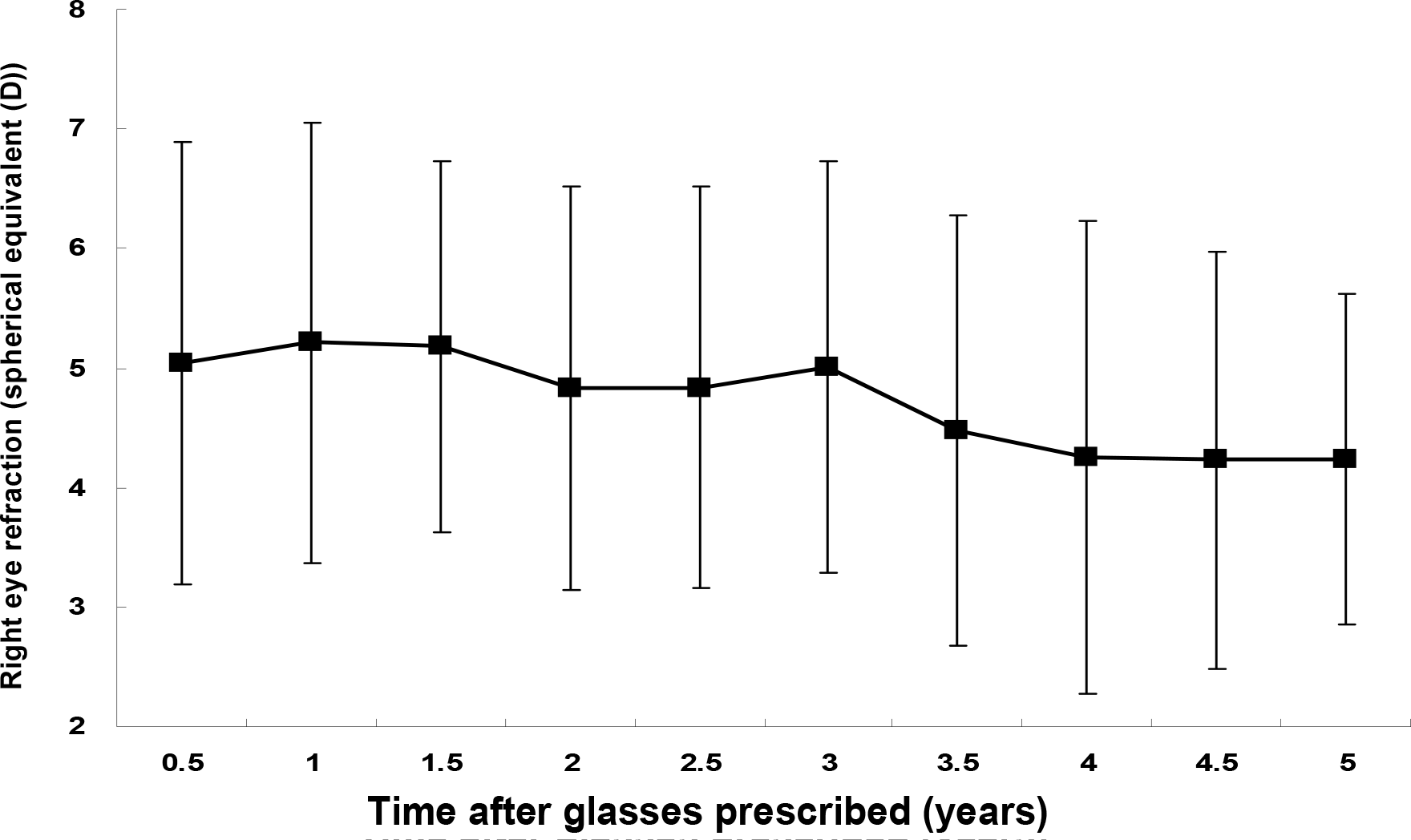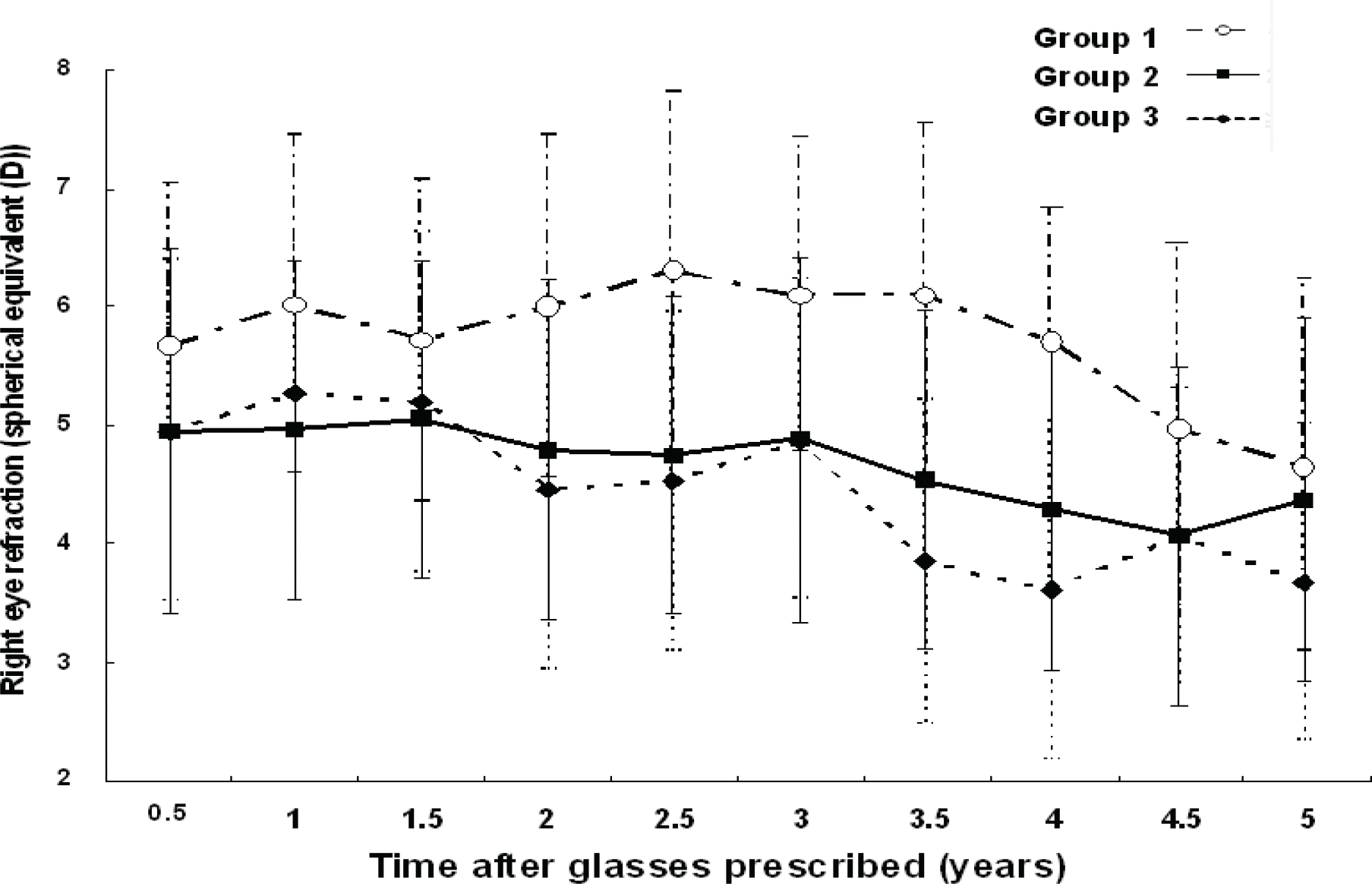Abstract
Purpose
To evaluate the effect of age wearing prescription glasses on changes in refractive error in accommodative esotropia
Methods
We retrospectively reviewed the charts of 63 patients with accommodative esotropia. The patients were divided into three groups according to their age when glasses were prescribed. Changes of the refractive error between the three groups were compared.
Results
The mean age at the first visit was 4.1±2.0 years and the mean follow‐ up period was 5.7±2.7 years. In children that began wearing glasses before two years of age, the spherical equivalent (SE) refractive error initially increased, peaked 2.5 years after starting to wear glasses, and slowly decreased thereafter. In children who started wearing glasses after two years but not before four years of age the SE refractive error increased and peaked 1.5 years after starting to wear glasses. For children who began wearing glasses after four years of age the SE refractive error increased and peaked after one year. Changes in the refractive error in the youngest age group were significantly different from the other two groups (p=0.064).
Go to : 
References
1. Von Noorden GK. Binocular vision and ocular motility. 6th ed.St. Louis: Mosby;2002. p. 311–55.
2. Raab EL. Etiologic factorsin accommodatie esodeviation. Trans Am Ophthalmol Soc. 1982; 80:657–94.
4. Repka MX, Wellish K, Wisnicki HJ, et al. Changes in refractive error of 94 spectacle treated patients with acquired accommodative esotropia. Binocular Vision. 1989; 4:15–21.
5. Rutstein RP, Marxh-Tootle W. Clinical course of accommodative esotropia. Optom Vis Sci. 1998; 75:97–102.

7. Kim DJ, Chun BY, Kwon JY. Five-year follow-up results of refractive accommodative esotropia. J Korean Ophthalmol Soc. 2007; 48:315–20.
8. Lambert SR, Lynn MJ. Longitudinal changes in the spherical equivalent refractive error of children with accommodative esotropia. Br J Ophthalmol. 2006; 90:357–61.

9. Sohn HJ, Paik HJ. Clinical features of refractive accommodative esotropia according to the age of onset. J Korean Ophthalmol Soc. 2006; 47:941–6.
10. Koretz JK, Rogot A, Kaufamn PL. Physiological strategies for emmetropia. Trans Am Ophthalmol Soc. 1995; 93:105–18.

11. Troilo D. Neonatal eye growth and emmetropization: A literature review. Eye. 1992; 6:154–60.
12. Atkinson J, Anker S, Bobier W, et al. Normal emmetro-pization in infants with spectacle correction for hyperopia. Invest Ophthalmol Vis Sci. 2000; 41:3726–31.
13. Atkinson J, Braddick O, Robier B, et al. Two infant vision screening programmes: prediction and prevention of strabismus and amblyopia from photo- and videorefractive screening. Eye. 1996; 10:189–98.

14. Hung LF, Crawford ML, Smith EL. Spectacle lenses alter eye growth and the refractive status of young monkeys. Nat Med. 1995; 1:761–5.

15. Schaeffel F, Glasser A, Howland HC. Accommodation, refractive error and eye growth in chicks. Vision Res. 1988; 28:639–57.
16. Smith EL, Hung LF. The role of optical defocus in regulating refractive development in infant monkeys. Vision Res. 1999; 39:1415–35.
Go to : 
 | Figure 1.SE refractive error in the right eyes according to the time after glasses prescribed. Increased SE refractive error was observed prior to 1 year after the glasses were prescribed. After then, the SE refractive error started to decrease continuously throughout the last follow-up. (SE=spherical equivalent) |
 | Figure 2.Spherical equivalent refractive error according to the time after glasses prescribed (Group 1: children prescribed glasses under 2 years of age, Group 2: children prescribed glasses at 2 to<4 years of age, Group 3: children prescribed glasses at 4-8 years of age). In the children prescribed glasses under 2 years of age, the SE refractive error increased initially and peaked 2.5 years after glasses prescribed. In the children prescribed glasses after 2 years of age, there was earlier peak of the SE refractive error than the children prescribed glasses under 2 years of age and gradual decrease of the SE refractive error after the peak. However, the SE refractive error in the youngest age group also showed continuous decrease in later years. (SE=spherical equivalent) |
 | Figure 3.Spherical equivalent refractive error according to the time after glasses prescribed (Group 1: children with initial SE refractive error of<6D, Group 2: children with initial SE refractive error of 6-9D). Compared to the lower initial hyperopic SE group, relatively small amount of decrease of SE refractive error was observed in the higher initial hyperopic SE group. (SE=spherical equivalent; D=diopter) |
Table 1.
Patient characteristics of three age groups
| Age when spectacles prescribed (years) | |||
|---|---|---|---|
| <2 | 2 to <4 | 4 - 8 | |
| Number of patients | 8 | 34 | 21 |
| Age at onset (months) | 14±5.88 | 31.50±6.81 | 50.62±14.37 |
| Initial SE* refractive error (D) | |||
| OD | 5.66±1.88 | 4.94±1.78 | 4.95±2.07 |
| OS | 5.69±1.84 | 5.00±1.75 | 5.01±1.65 |
| Presence of amblyopia (No) | |||
| OD | 2/8 (25%) | 7/34 (21%) | 4/21 (19%) |
| OS | 2/8 (25%) | 6/34 (18%) | 4/21 (19%) |
| Angle of deviation (esodeviation, prism diopter) | 32.51±12.97 | 31.94.±14.81 | 30.12±11.54 |
Table 2.
Spherical equivalent (SE) refractive error in right eye according to the time after glasses prescribed according to age when glasses were prescribed
|
Age when glasses prescribed (years) |
|||
|---|---|---|---|
| Time interval after glasses prescribed (years) |
<2 |
2 to <4 |
4 - 8 |
| SE* refraction in right eye (D†) | SE refraction in right eye (D) | SE refraction in right eye (D) | |
| Mean± SD‡ | Mean± SD | Mean± SD | |
| <0.5 | 5.66±1.88 | 4.94±1.78 | 4.95±2.07 |
| 0.5-1 | 6.02±1.50 | 4.96±1.87 | 5.26±1.95 |
| 1-1.5 | 5.71±1.48 | 5.05±1.53 | 5.19±1.70 |
| 1.5-2 | 6.00±1.76 | 4.79±1.85 | 4.46±1.33 |
| 2-2.5 | 6.30±1.59 | 4.74±1.51 | 4.52±1.86 |
| 2.5-3 | 6.10±1.85 | 4.88±1.69 | 4.87±1.83 |
| 3-3.5 | 6.10±1.69 | 4.54±1.68 | 3.84±1.85 |
| 3.5-4 | 5.70±1.69 | 4.28±1.89 | 3.61±2.13 |
| 4-4.5 | 4.96±1.75 | 4.06±1.58 | 4.06±2.12 |
| 4.5-5 | 4.65±1.40 | 4.37±1.14 | 3.67±1.82 |
Table 3.
Spherical equivalent (SE) refractive error in the right eye according to the time after glasses prescribed for children with initial SE refractive error of <6D and 6-9D
|
Initial SE refractive error |
||
|---|---|---|
| Time interval after glasses S prescribed (years) |
<6D |
6-9D |
|
SE* refraction in right eye (D†) |
SE refraction in right eye (D) |
|
| Mean± SD‡ | Mean± SD | |
| <0.5 | 4.87±1.14 | 7.04±0.93 |
| 0.5-1 | 4.63±1.10 | 7.18±0.96 |
| 1-1.5 | 4.34±0.94 | 6.70±0.89 |
| 1.5-2 | 3.99±1.22 | 6.54±0.93 |
| 2-2.5 | 3.78±1.13 | 6.42±1.02 |
| 2.5-3 | 3.86±1.12 | 6.51±1.19 |
| 3-3.5 | 3.41±1.33 | 6.46±1.17 |
| 3.5-4 | 3.20±1.24 | 6.53±0.90 |
| 4-4.5 | 3.07±1.29 | 5.95±0.91 |
| 4.5-5 | 2.78±1.21 | 5.36±0.98 |
Table 4.
Generalized linear mixed model for the change of mean spherical equivalent refractive error




 PDF
PDF ePub
ePub Citation
Citation Print
Print


 XML Download
XML Download